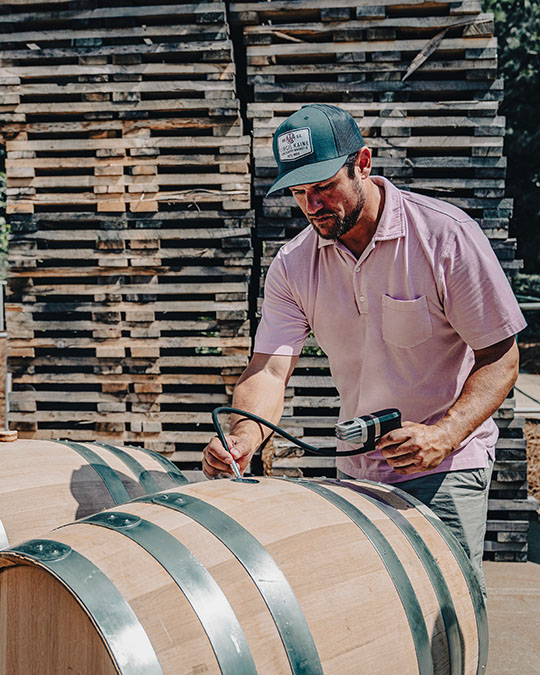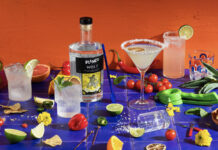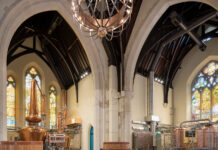Atlanta native David Szlam was a chef who found his way into craft spirits. After graduating from the California Culinary Academy’s Le Cordon Bleu Culinary Program, he worked with legendary San Francisco Bay Area chefs, including Gary Danko, Melissa Perello, Roland Passot, and the great Alice Waters.
After moving to Charleston in 2006, Szlam opened his own restaurant, Cordavi, which was named one of twenty best new restaurants in the country by Esquire in 2006. He also helped open other beloved Charleston spots like Butcher & Bee. The economic crash in 2008–2009, however, caused him to rethink his future — yet still follow his palate. Like so many Southerners, he loved bourbon and had visions of how the ubiquitous bourbon and ginger ale could shine if it were made using high quality ingredients. In 2011, he launched Virgil Kaine with its flagship ginger-infused bourbon, and in 2013, partnered with fellow chef, Ryan Meany, to grow the brand.
Szlam has gone on to evolve Virgil Kaine’s whiskey infusions to highlight flavors inherent in bourbon and rye. In his own words, he tells us about their unique process and how he has continued to build the brand.

Tell us about your path into craft spirits and how your chef background informs what you create.
Back in [the mid-aughts], we had a restaurant called Cordavi. Me and my partner, [chef] Corey Elliot, had a love for, of course, food, but creating experiences and memorable moments for people. Cooking [and creating experiences] was a way of sharing love with people. Seeing them happy fulfilled my life, in a sense. Obviously, in 2008–2009, all kinds of things hit the fan, so I had to adjust and go a different path but wanted to stay in Charleston.
I’d just had a baby boy. I met my wife in Charleston and I love [the city] and the water. It’s home and I didn’t wanna relocate… I was taking a look back at my life, saying my goal was to be the number one chef in America or have the best restaurant. But did I really want to give up everything else that means so much to me? So to stay in Charleston, I dove into things like real estate because of the market crash, then started consulting a bit.
I helped open [Charleston’s acclaimed] Butcher & Bee, and I’m still a small partner in that and [its sister cafe] The Daily. Michael Shemtov was a really good friend of mine and wanted my help in writing the first menu. During that process, I always loved bourbon, but noticed in the South, myself included, everybody just drank bourbon and ginger ale. I thought there’s gotta be a better way to have these flavors combined without putting high fructose corn syrup in your body. To have a similar taste experience, utilizing great ingredients.
It’s similar to food where we would take comfort food and put a spin on it or deliver it in a way people would have never imagined, but the flavors remind them of home or [childhood]. That was the same attitude we had thinking about Virgil Kaine. We started with ginger-infused bourbon, partnering with John Warren of Spade and Clover Gardens [in nearby Johns Island, SC]. He grows some delicious ginger, is an awesome farmer, and takes risks. He grows things people don’t typically grow in Charleston.
We macerate his ginger with whiskey, a little bit of vanilla, lime, cinnamon. All those notes that you love in ginger ale, right? But without the crap… The thought was people would just mix it with soda and a bit of lime and they would have a lighter version of bourbon and ginger ale or a whiskey ginger highball. So that’s how it started, then we started to incorporate other SKUs to create a business around it. Now we’re just having fun.
What makes your whiskeys different from others?
I look at the whiskey category from a chef’s perspective. We look at it as a base ingredient that we build upon, though a lot of people will look at it as a whiskey in the end. I don’t want to discount all the work that has gone into [the whiskey] so I can make it into something beautiful. But we look at [the mashbill] as an ingredient, delivered to us.
Then we’re really trying to build upon those flavor profiles, not hide them, not mask them in any way. We’re really trying to…find those hidden notes that aren’t screaming at the consumer and highlight them [for example, their spice and citrus-touched Robber Baron rye whiskey or their vanilla pod-smoked Eighth Notch bourbon].
In our LTOs [limited time offerings], we find those hidden flavor profiles and highlight them to shine through the whiskey a little more [e.g., they’ve worked with everything from green tea to cherries]. I think that’s what we do well and we try not to do things that have been done in the industry before. I say “think out of the barrel.” Utilize ingredients that harmonize together, deliver spice, sweetness, and acidity and all those wonderful flavors that work together.
So who actually distills your whiskey?
We source everything from Indiana from MGP. We’ve been sourcing from them from day one. We love their product. When I go there, I’m always shocked by how big the facility is and how industrial it looks. But the values are still [our] core values. They sit on one of the largest natural aquifers in the world, so the water’s clean and pure. They use great grains and they’ve been distilling for [close to] 100 years… We’ll then macerate a portion of [our MGP blend] with local ingredients, filter it, and bottle it.
How does being based in Charleston inform your business?
I’m thankful to Charleston and the people in the industry. To how hospitable everyone is and how supportive they are of local products, from industry favorite bars like Proof to the renowned Husk… It’s just amazing how people want to see you succeed.
What do you feel are the key elements of getting your brand placed?
You’re gonna move more volume at retailers, so I think it’s important to find the right retailers and start small. Curate about 10 to 15 that you really support — or five, if your budget allows for only five. Curate relationships and make sure they know you’ve got their back. You’re gonna be in there helping get that product to move off the shelf. You’re gonna be doing the tastings and… get them to restock the shelves.
Once you have customers purchasing the product, that person’s telling another person, and you’re creating a little pocket. Once you create that relationship, then you can spend a little less time there and add other people to your accounts list. Try not to go too wide too fast.
I think it’s important to identify on-premise-wise what type of product you have. If you’re more craft, you probably want those kinds of influencer accounts. If you’re just a badass bourbon under 25 bucks or a badass vodka under 20 bucks, then go to some high-volume accounts and get your name out there as quickly as possible. But curate those relationships.
Understanding your market space is really important to your strategy. I cover the range. Husk captures all the tourists and foodies and all that, but Proof is a beloved locals’ bar and craft cocktail people are flocking there.
How do you envision the world of small-batch spirits evolving in the coming years?
I think that’s a very interesting question because if you look at the landscape today, it’s a beautiful landscape, right? There are so many craft distillers that it’s challenging to be different. Which is good. Challenge is a great process in evolving the space into something bigger and better. Who knows where it’s gonna end up? But I really think you’re seeing it now with some of the bigger brands and some of the smaller variants, like more farm-to-table, grain-to-table.
I think people are going to start experimenting with different grains, different mashbills. They’re going to add, you know, chocolate malted barley to bourbon or start to play around with other finishes. I think it’s gonna get pretty creative. With our last whiskey, we took toasted barrels and smoked them with dried vanilla beans. And Whisky Advocate just gave us 94 points on it.
I think there will be some sense of circling back to tradition. I feel like in about five years or so, people are gonna be like, “Okay, enough of the finished crap. Just give me the best original formula.” You know how that happens. I think that’s where those who are really focusing on where their grains are grown will be ready.
I always used to say Scotch makers were my biggest inspiration because they’ve been doing this forever. Blending and finishing. We strive to do something that has never been done and have the whiskey really speak to us. I have to tell you, it’s getting more and more difficult, because I don’t want to just do something because it hasn’t been done. It has to make sense and it has to also accentuate the bourbon, so it gets challenging to check all the boxes, because there’s some pretty creative people out there.








